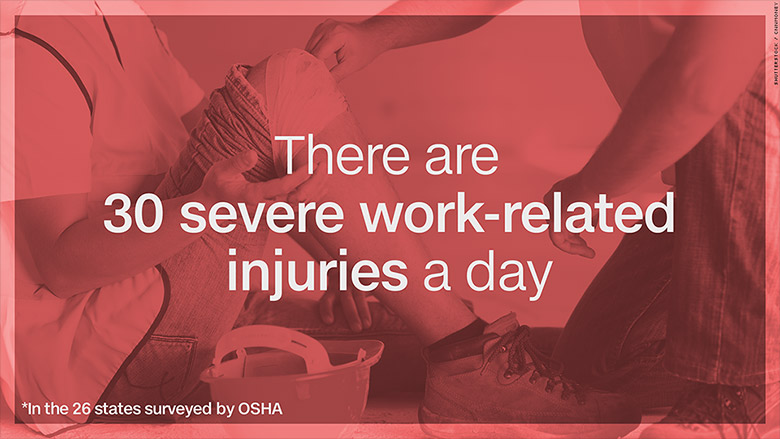
It's safer to go to work now, but lots of people are still seriously injured on the job.
A new report from the Occupational Safety and Health Administration shows that there were 10,388 severe injuries caused by workplace conditions in 2015. These injuries led to 7,636 hospitalizations and 2,644 amputations. In a handful of cases there were even reports of people having their eyes gouged out.
OSHA collected the data from 26 states that have higher safety standards than those mandated by federal regulations. The reported cases amounted to 30 severe work-related injuries a day.
The manufacturing industry had the highest proportion of accidents -- it accounted for 57% of all amputations and 26% of all hospitalizations.
Among the other industries with high rates were construction, transportation and warehousing as well oil and gas extraction.
The report, which was released Thursday, is the result of new regulations, which require companies to report serious workplace accidents within 24 hours. The new regulatory system was implemented in 2015 to reduce the number of these injuries.
"Too often, we would investigate a fatal injury only to find a history of serious injuries at the same workplace. Each of those injuries was a wake-up call for safety that went unheeded," OSHA said in a statement.
Related: Violence on the job, suicides and immigrant deaths on the rise
OSHA estimates that roughly 50% of all injuries in the 26 states where it collects data, aren't reported.
One possible reason for this is that smaller companies aren't aware of the new system.
However, some companies actively try to hide unsafe conditions or have failed to report hospitalizations. In one instance, a manufacturer even blocked investigators from entering a building by parking forklifts in front of it.
To combat this, OSHA has raised fines for unreported injuries from up to $1,000 to as much as $7,000, and plans to hike them further.
Apart from the extreme cases, most companies have been responsive. Most of the time OSHA doesn't even have to send officials to the company for changes to be implemented.
The ultimate goal of the new system is to make workplaces safer.
"[W]e know that each case reported to us under this new requirement involved a human being who went to work one day and suffered an unexpected trauma. Some, along with their co-workers and families, were changed forever," the statement said.
